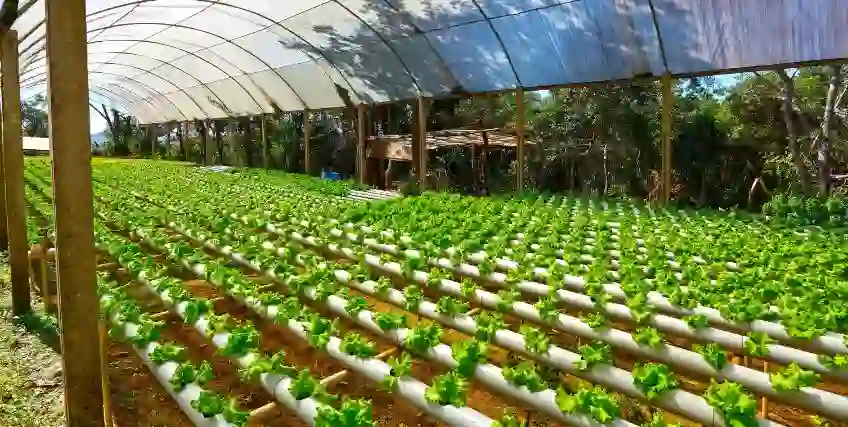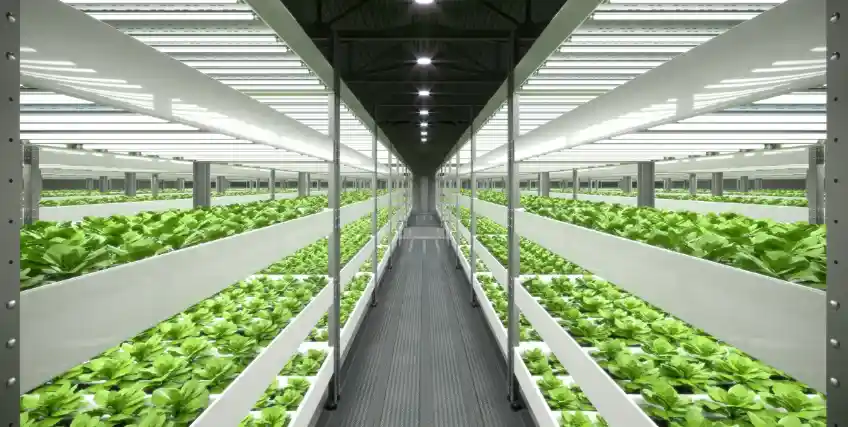Expand Your Hydroponic Business
with the Right Small Business Loan
Looking for Business Financing?
Apply now for flexible business financing. Biz2Credit offers term loans, revenue-based financing, lines of credit, and commercial real estate loans to qualified businesses.
Set up a Biz2Credit account and apply for business financing
Hydroponic farming is changing the way agriculture has been done not only in the US, but across the world. In this type of farming, instead of soil, crops thrive in nutrient-rich water, making it possible to grow food in cities, warehouses, and even old factories. There is a clear appeal here: yields are higher, harvests can be done faster, and fresh produce can reach local markets quickly. But there's a catch too. It is not cheap to set up a hydroponic system; it requires serious money
From lighting and water systems to nutrient solutions and climate controls, the costs can overwhelm small business owners, startups, and even family farms. That's where a loan for hydroponic farming becomes essential. Financing provides growers with access to capital for equipment, operating expenses, and expansion opportunities. With proper support, hydroponic operations can scale faster while staying competitive in the booming local food market.
Government agencies like the USDA and its Farm Service Agency (FSA) also recognize the importance of modern farming systems. Through loan programs and other government funding for farmers, they make financial assistance more accessible to beginning farmers, ranchers, and entrepreneurs. Combined with private lenders and alternative funding sources, these opportunities give hydroponic growers the foundation they need to succeed.
Hydroponics isn't just a trend. It's becoming the future of agriculture, driven by sustainability, urban growth, and the right financial backing.
What is Hydroponic Farming?
Hydroponic farming is a method of growing crops without soil, where plants rely on nutrient solutions and controlled water systems. It's becoming a preferred choice for many growers in the US because it allows production in places where traditional farming struggles. With the right setup, leafy greens, herbs, and other horticulture crops can thrive indoors, year-round.
There are several types of hydroponic systems. The Nutrient Film Technique (NFT) uses a constant flow of water and nutrients over plant roots. Deep Water Culture relies on suspending plants in oxygenated, nutrient-rich water. Aeroponics involves misting roots with nutrient solutions, while aquaponic systems combine fish farming with plant production, creating a balanced cycle of growth. Each method has its own startup costs and technical needs, which is why many growers look for a loan for hydroponic farming to cover equipment and operating expenses.
The USDA and Farm Service Agency (FSA) recognize hydroponic farming as part of modern agriculture. In fact, programs like FSA loans and microloans are designed to support beginning farmers and small business operations venturing into indoor and vertical farming. These programs provide funding sources and sometimes even a subsidy, making the jump into hydroponic operations more financially viable.
Hydroponic farming also ties into broader initiatives around sustainability and renewable energy. By using less land and up to 90% less water compared to traditional farming, hydroponics addresses climate and resource challenges while boosting local food supply.
Who Uses Hydroponic Farming in the US?
Hydroponic farming is no longer a niche practice. Across the US, a wide range of growers and entrepreneurs are adopting this method to produce high-quality crops. From small business owners to large hydroponic operations, the user base is expanding quickly.
Many beginning farmers see hydroponics as a way to enter agriculture without needing large tracts of land. Instead, they set up compact indoor farming systems in urban areas, where space is limited but demand for fresh produce is high. For these farmers, a loan for hydroponic farming or access to farm start up grants can make the difference between an idea and a running business.
At the same time, entrepreneurs and agritech startups are drawn to the opportunities in hydroponics. They view it as a scalable model, fueled by demand for local, sustainable, and value-added agricultural products. Venture capital interest in vertical farming also supports this momentum, although most projects still require reliable lenders and loan programs to cover major expenses.
Traditional family farms and ranchers are also investing in hydroponics. Some use it to diversify crops and reduce risks tied to weather or soil conditions. Others adopt it to boost yields of high-demand items like leafy greens and herbs. Non-profit organizations and educational institutions are joining in too, using hydroponics to teach students about sustainability and modern farming operations.
Together, these users form a diverse ecosystem. And while their goals differ, many rely on farming loans and grants or USDA-backed financial assistance to fund their projects.
The Costs Involved in Hydroponic Farming
Getting started with hydroponic farming isn't cheap. The initial investment is often what pushes many growers to seek a loan for hydroponic farming. Unlike traditional agriculture, hydroponics depends heavily on equipment, technology, and ongoing inputs.
Upfront costs include lighting systems, climate controls, water pumps, and nutrient delivery systems. For indoor farming setups, energy-efficient LED grow lights can run thousands of dollars, while advanced irrigation systems and climate control add even more. Depending on the scale, initial setup for small hydroponic operations can range from $500 to well over $100,000. Large vertical farms require far higher capital.
Then come the ongoing operating expenses. Energy bills, nutrient solutions, seeds, and labor all add to monthly costs. Even with sustainability goals and renewable energy offsets, these expenses remain significant. Farmers must also budget for potential system failures, which could mean replacing pumps, filters, or sensors.
Because of these financial challenges, growers often turn to multiple funding sources. Options include USDA-backed FSA loans, microloans for beginning farmers, or private lenders offering working capital loans. In some cases, farming grants or state government initiatives can help reduce debt pressure. Still, most hydroponic farmers need structured financing with clear repayment terms to stay afloat.
For many, the reality is clear. Hydroponics offers big opportunities but requires serious upfront capital. Without accessible financing and government funding for farmers, it can be tough for small businesses and family farms to compete.
Benefits of Hydroponic Farming
Hydroponic farming brings a unique set of advantages that make it attractive for growers, small businesses, and even large commercial operations. Here's why many seek a loan for hydroponic farming to unlock these benefits.
1. Higher Yields and Faster Growth
Hydroponic systems create an ideal environment for plants. With controlled nutrient delivery and water access, crops grow faster and produce higher yields compared to soil farming. Farmers growing leafy greens and herbs often achieve multiple harvests per year, which boosts profits. This efficiency is why many hydroponic operations rely on loan programs to scale their setups and meet growing demand from local markets and restaurants.
2. Efficient Use of Resources
One of the biggest draws of hydroponics is sustainability. Systems use up to 90% less water than traditional farming while also minimizing land use. With the right setup, growers can also integrate renewable energy for lighting and temperature control. These efficiencies not only support eco-friendly goals but also reduce long-term operating expenses. A loan for hydroponic farming allows businesses to invest in these energy-saving systems, lowering costs while staying competitive.
3. Flexible Location Options
Hydroponic farming isn't tied to rural land. Farmers and entrepreneurs can set up operations in warehouses, greenhouses, or even shipping containers in urban areas. This flexibility supports local food systems and reduces transportation costs. Urban indoor farming models are especially popular among startups and beginning farmers who may not own large fields. Access to farming grants or microloans helps make these smaller, location-flexible ventures possible.
4. Profitability Potential
Hydroponics allows farmers to supply fresh, high-value agricultural products year-round. Crops like lettuce, spinach, and herbs often sell at premium prices. By focusing on value-added produce and consistent supply, growers can achieve strong returns. Securing a loan for hydroponic farming or leveraging farming loans and grants can provide the capital needed to expand production and increase revenue streams. For many, profitability is what makes hydroponics worth the investment.
Challenges and Disadvantages
While hydroponic farming offers strong potential, it comes with hurdles that growers can't ignore. Many of these challenges explain why a loan for hydroponic farming or government funding for farmers becomes necessary.
1. High Upfront Investment
Setting up a hydroponic system requires significant capital. Between LED grow lights, nutrient delivery, and water recycling systems, costs add up quickly. For small businesses and family farms, this can be overwhelming without access to a farm loan or farming grants. USDA-backed FSA loans and microloans help beginning farmers secure funds, but repayment obligations still remain. The heavy startup investment is one of the main barriers to wider adoption.
2. Energy Dependency
Hydroponic farming depends on constant electricity. Lighting, heating, and water circulation require reliable power sources, which drive monthly operating expenses higher than traditional farming. While renewable energy can offset some of these costs, the initial setup isn't cheap. Farmers often turn to loan programs to fund solar panels or energy-efficient upgrades. Without stable financial assistance, these energy demands can eat into profitability, making it difficult for small hydroponic operations to sustain long-term.
3. Technical Skills Needed
Managing a hydroponic farm isn't as simple as planting seeds. Growers need to understand pH balance, nutrient solutions, climate control, and system maintenance. Mistakes can lead to crop loss and wasted resources. For beginning farmers or startups, training costs can be another expense added to the loan amount. Access to farming funding or non-profit training initiatives can ease this learning curve, but technical know-how remains a key challenge for many operators.
4. System Failures and Risks
Unlike traditional soil farming, hydroponic systems are highly dependent on technology. A pump failure, power outage, or contamination in nutrient solutions can destroy entire crops in hours. These risks make insurance, backup systems, and maintenance critical but costly. With the right loan for hydroponic farming, growers can invest in safeguards, yet repayment stress adds pressure. This reliance on technology is often cited as one of the biggest vulnerabilities in modern hydroponic operations.
Importance of Financing for Hydroponic Farming
Hydroponic farming is promising, but it's not cheap to manage. That's why securing a loan for hydroponic farming is often the turning point for many growers. Financing covers the steep upfront investment while also providing support for ongoing operating expenses.
For small businesses, loan programs can mean the difference between staying small and scaling up. With access to capital, farmers can expand production areas, install new hydroponic systems, and even explore aquaponic operations. Financing also gives them breathing space to manage repayment schedules while continuing to serve local markets.
The USDA and its Farm Service Agency (FSA) play a central role in offering farm loans. Through FSA loans and microloans, beginning farmers and family farms can access flexible credit with competitive interest rates. These loans also support sustainability initiatives, helping farmers adopt renewable energy solutions or diversify into value-added agricultural products.
Private lenders and alternative funding sources also fill gaps where government aid may fall short. Non-profit organizations, state governments, and community programs sometimes step in to provide farming grants or subsidies. Combined, these options allow growers to choose the financial path that fits their farming business model.
Ultimately, financing is more than just money. It's a tool for entrepreneurs and ranchers to stay competitive in a growing market. Without steady financial assistance, many hydroponic operations would struggle to balance growth with costs.
Loan for Hydroponic Farming in the US: Options Available
Finding the right loan for hydroponic farming depends on the grower's needs. Different financing options can cover everything from setup costs to everyday operating expenses.
1. Term Loans
Term loans are one of the most common financing options for hydroponic operations. They provide a lump sum that growers repay over set periods with fixed interest rates. These loans are often used for large-scale expansions, such as adding new greenhouses or vertical farming towers. While repayment schedules are predictable, they require a solid business plan to qualify. Many entrepreneurs use this option when scaling from small business setups into full commercial hydroponic operations.
2. Equipment Loans
Hydroponics is equipment-heavy. From LED lighting systems to advanced climate controls and nutrient delivery setups, costs add up quickly. Equipment loans help farmers spread those expenses over time. These loans typically use the equipment itself as collateral, making it easier for growers to qualify. For beginning farmers or startups, equipment financing reduces the burden of paying everything upfront, while still ensuring their farm runs efficiently with modern hydroponic systems.
3. Working Capital Loans
Day-to-day expenses can weigh heavily on growers. Working capital loans provide quick access to cash for seeds, nutrient solutions, energy bills, or labor costs. Unlike term loans, these are designed for short-term needs, keeping hydroponic operations running smoothly without interruption. Many small businesses use them to cover seasonal dips or delays in produce sales. Having access to this kind of financial assistance is often what keeps smaller hydroponic farms stable during tough months.
4. Microloans and FSA Loans
The USDA's Farm Service Agency (FSA) offers direct loans, guaranteed loans, and microloans for smaller farming businesses. These are designed for beginning farmers, family farms, and ranchers who need manageable loan amounts with flexible repayment. FSA loans often come with lower interest rates and are backed by government programs, making them attractive to farmers building sustainable and renewable-energy-driven operations. Combined with farm start up grants, they give growers a path to launch and expand without taking on overwhelming debt.
Government Support and Grants
The US government actively supports hydroponic growers through loans, subsidies, and grants. Accessing these resources often makes the difference between surviving and expanding in this competitive market.
1. FSA Loan Programs
The USDA's Farm Service Agency (FSA) offers a range of loan programs, including direct operating loans, guaranteed loans, and microloans. These options help beginning farmers, family farms, and ranchers finance their hydroponic operations. FSA loans are especially important for those without access to traditional lenders. They provide fair interest rates and repayment terms that allow hydroponic businesses to manage both startup and ongoing operating expenses.
2. Farm Start Up Grants
For those just entering the industry, farm start up grants offer crucial financial assistance. These grants often target entrepreneurs and small business growers who lack significant collateral. While competitive, they reduce the need to rely entirely on debt financing. Grants allow new hydroponic farmers to invest in equipment, nutrient solutions, and training without increasing their repayment obligations. For many, securing a start up grant is the first step toward building a sustainable farming business.
3. Farming Grants and Subsidies
Beyond startup grants, there are broader farming grants and subsidies available at both federal and state levels. These programs help reduce costs tied to renewable energy upgrades, water efficiency systems, or sustainable horticulture practices. They are especially helpful for growers expanding vertical farming or aquaponic systems. By lowering upfront costs, these grants reduce the size of the loan for hydroponic farming a grower may need, easing long-term repayment stress.
4. State and Non-Profit Support
Individual state governments and non-profit organizations run initiatives to promote modern agriculture. Some provide subsidies for indoor farming, while others support community-driven hydroponic projects. These programs often focus on sustainability, nutrition access, and innovation. In some cases, non-profits even provide direct funding sources for family farms or school-based hydroponic operations. Combined with federal programs, these initiatives create a broader safety net for farmers seeking government funding for farmers and sustainable farming solutions.
Alternative Farming Funding Options
Not every grower relies only on USDA or state-backed loans. Many hydroponic businesses explore alternative funding routes to get the capital they need for growth.
1. Private Investors and Venture Capital
Hydroponics has caught the attention of private investors and venture capital firms. These backers often look for scalable vertical farming projects with strong business plans and high-profit potential. While the money can be significant, it usually comes with ownership stakes or strict performance terms. Still, for ambitious entrepreneurs and startups, private funding can provide larger capital than a typical loan for hydroponic farming, supporting rapid expansion of commercial-scale hydroponic operations.
2. Crowdfunding Platforms
Some hydroponic growers turn to crowdfunding as a way to raise funds directly from consumers or local supporters. Platforms allow farmers to share their story and attract small contributions that add up. For community-driven farms and non-profit organizations, this can be a creative way to access financing without debt. While it doesn't replace farming loans and grants, it's a supplementary option for projects focused on sustainability, local food systems, or renewable energy initiatives.
3. Cooperatives and Partnerships
Joining a cooperative or forming partnerships with other growers can spread costs and open doors to collective funding. Farmers can pool resources for nutrient solutions, equipment, or distribution networks. Some cooperatives even negotiate loan programs with lenders on behalf of their members. For family farms and ranchers looking to balance risk, these collaborations can make hydroponic farming more financially achievable while reducing the pressure of large loan amounts or strict repayment terms.
4. Special Initiatives and Programs
In addition to traditional grants, some states and non-profits launch initiatives focused on innovation and sustainability. Programs may fund renewable energy projects tied to indoor farming or offer subsidies for new hydroponic systems. Others focus on nutrition access in underserved areas, backing local growers through financial assistance. While these opportunities are competitive, they supplement a loan for hydroponic farming by cutting costs and diversifying funding sources. For many growers, these niche programs provide the push needed to scale.
Future of Hydroponic Farming in the US
The future of hydroponic farming in the US looks bright. As demand for fresh, local produce grows, hydroponic operations are expected to expand across both urban and rural areas. Industry analysts predict strong growth in leafy greens and herbs, where quick harvest cycles and premium pricing offer attractive returns. For many growers, securing a loan for hydroponic farming will remain essential to keep up with this rising demand.
Technology will continue shaping the sector. Advanced hydroponic systems, renewable energy integration, and climate-smart designs will make farms more efficient. Government funding for farmers and USDA-backed loan programs will likely evolve to support these innovations, especially those tied to sustainability and water efficiency. State governments and non-profit organizations are also expected to expand their initiatives, encouraging more beginning farmers and small businesses to join the market.
Still, challenges remain. High operating expenses and repayment obligations mean growers must carefully manage their financial strategies. A mix of farming grants, subsidies, and private investment will help balance costs while allowing hydroponic businesses to innovate.
Overall, hydroponics is set to play a central role in the nation's agricultural future, powered by financial assistance, evolving loan options, and a push toward sustainability.
Trusted by Thousands of Small Business Owners in America.**
Simply because we get what you go through to build a business you believe in.
**Disclaimer: All stories are real, as told by real business owners. Customers do not receive monetary compensation for telling their stories.
From One Entrepreneur to Another: We Get You
We understand what's behind building a business you believe in.
All stories are real, as told by real business owners. Customers do not receive monetary compensation for telling their stories.



Articles on Loans for Hydroponic Farming
Government Grants for Hydroponic Farming: How to Secure Funding for Your Agri-Business
Hydroponic farming is a growing industry centered around urban agriculture. The hydroponics market in North America has an estimated value of $3.64 billion in 2024...
Grants for Hydroponic Farming: Funding Options to Grow Your Agribusiness
Farmers today are looking for more efficient ways to grow food crops. Because of this, hydroponic farming is on the rise. Hydroponic farming is a nearly billion-dollar...
Hydroponic Farm Business Loans: The Complete Funding Options Guide
Hydroponic farming is revolutionizing the way food is grown, enabling year-round production without the need for soil. It’s efficient, sustainable, and increasingly popular...
Frequently Asked Questions on Loans for Hydroponic Farming
1. What is the average startup cost for hydroponic farming in the US?
Startup costs vary widely. Depending on the setup, the initial set cost may require $500–$100,000 and in some cases, it can exceed that too. Many growers use a loan for hydroponic farming to cover these costs.
2. Are there farming grants available for hydroponic farmers?
Federal and state governments offer farming grants and subsidies to reduce upfront expenses. These grants often target sustainability, renewable energy, and indoor farming projects.
3. Can beginning farmers qualify for a loan for hydroponic farming?
USDA’s Farm Service Agency (FSA) provides microloans and loan programs for beginning farmers. These programs are designed to support smaller loan amounts and manageable repayment terms.
4. What role does government funding for farmers play in hydroponics?
Government funding for farmers supports everything from startup costs to renewable energy upgrades. Programs also promote value-added agricultural products, helping hydroponic farms remain competitive while expanding production.
5. Are hydroponic farms profitable compared to traditional farming?
Hydroponic farms can be profitable, especially with crops like leafy greens and herbs. Their year-round production and shorter growth cycles often bring quicker returns, though operating expenses remain high.
Frequent searches leading to this page
Term Loans are made by Itria Ventures LLC or Cross River Bank, Member FDIC. This is not a deposit product. California residents: Itria Ventures LLC is licensed by the Department of Financial Protection and Innovation. Loans are made or arranged pursuant to California Financing Law License # 60DBO-35839



